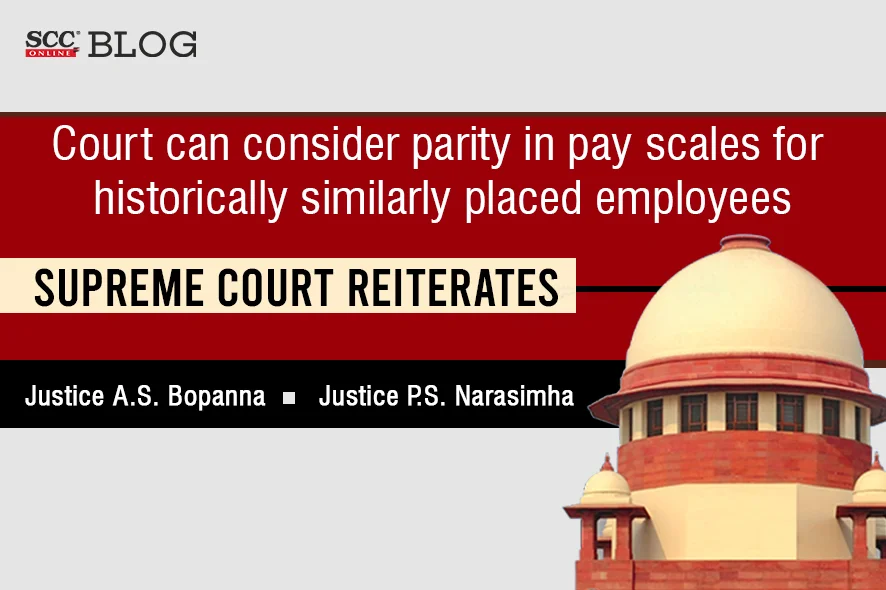Supreme Court: In an appeal by the Union of India challenging order passed by the Delhi High Court on 14-10-2014 setting aside orders passed by Central Administrative Tribunal (‘CAT’) and thereby allowing the relief of parity in pay scales in terms of recommendations in 6th Central Pay Commission (‘6th CPC’), the Division Bench of A.S. Bopanna* and P.S. Narasimha, JJ. upheld the High Court’s conclusion to reiterate that historical similarity in pay scales can be considered while allowing same pay scale for similar posts.
Background
The Association of Employees in the Head Quarters of Ordnance Factory Board sought upgradation of pay scales of Assistant and Personal Assistants of Ordnance Factory Board as given to similarly placed employees of Central Secretariat Service (‘CSS’) and equivalent posts in Armed Force Headquarters Civil Service (‘AFHCS’) Cadre and other similar cadres. However, the same was rejected by the Ministry of Defence vide order dated 20-04-2010, communicated on 7-06-2010. The said aspect was brought before the CAT, the same got declined, but the writ proceedings before Delhi High Court succeeded.
The High Court analysed that the respondents were historically treated as equals to CSS/CSSS employees, enjoyed equal pay and all benefits and accordingly issued direction to fix the same with effect from the same date as was first given to them.
Court’s Analysis on Parity in Pay Scales
The Bench perused the High Court’s consideration while allowing parity in pay scales for the respondents. The appellants highlighted the limited power of judicial review in matters pertaining to pay scale. Hence, before getting into correctness of High Court’s decision, the Bench went on to the issue regarding Court’s power to determine pay scale.
As relied upon by the appellants, the Court noted that State of Punjab v. Jagjit Singh, (2017) 1 SCC 148 stated that the question of equation of pay scales did not arise where there was no comparison between the two sets of employees of different organizations. Further, in Union of India v. Indian Navy Civilian Design Officers Assn., 2023 SCC OnLine SC 173 the Court restricted the task of job evaluation generally left to the expert bodies like Pay Commissions.
It also perused the respondents’ reliance on Union of India v. Dineshan K.K., (2008) 1 SCC 586 which per se supported such matters to be left to the executive and expert bodies without Court’s interference but restricted the same to be taken as an absolute rule leaving the aggrieved employee with no remedy in case of being unjustly treated by arbitrary State action or inaction. The Court noted that “relief cannot be denied to the employees when the entitlement is denied due to irrational consideration without application of mind to the facts involved in the case by the employer, thereby denying the benefits to the employees.”
The Bench explained the fact that if the respondents were the employees in the headquarters of the Ordnance Factory and were similarly placed as the Assistants in CSS/CSSS Army Headquarters and other similarly placed organisations, and regarded the High Court’s conclusion to be ‘unexceptionable’. The Court explained that in Union of India v. Manoj Kumar, 2021 SCC OnLine SC 646, although the Court examined the same provisions as under question in the instant matter, the High Court had considered the historical similarity to consider the applicable pay scale while concluding against discrimination with similarly placed employees in the headquarters of the Ordnance Factories. The Bench approved of such consideration falling within the parameters permitted for Courts to consider the pay scales.
Pay Parity for Similarly Situated Employees
The Bench relied on All India Naval Clerks Association and Others vs. Union of India and Others in Civil Appeal arising out of Special Leave Petition (Civil) No.29204 of 2019 dated 27.07.2022 and acknowledged that “parity of pay scales vis-à-vis LDCs, UDCs, Assistants/PAs and Stenographers, was maintained even prior to 01.01.1986 under the Third Central Pay Commission recommendations (for the period of 01-01-1973 to 31-03-1985). This parity was continued in the Fourth Central Pay Commission recommendations (with effect from 01.01.1986 to 31-12-1995) and the Fifth Central Pay Commission recommendations (for the period 01-01-1996 to 14-09-2006). The post of Assistants, PAs and Stenographers is governed by Director General Ordnance Factories Headquarters Civil Service Rules, 1977.”
The Bench explained that the High Court in the impugned decision did not equate two sets of employees in different organisations but regarded the Pay Commission recommendations along with pay scales recommended to similarly placed employees employed in the headquarters, reflected the discrimination despite historical similarity and thereby rectified the error. The said decision did not call for interference in the Bench’s view. Therefore, the Bench dismissed the instant appeal finding the same devoid of merit.
[Union of India v. D.G.O.F. Employees Assn., 2023 SCC OnLine SC 1471, decided on 9-11-2023]
Judgment authored by: Justice A.S. Bopanna
Know Thy Judge | Supreme Court of India: Justice A.S. Bopanna
Advocates who appeared in this case :
For Appellants: Senior Advocate R. Bala, Advocate on Record Arvind Kumar Sharma, Advocate Rajesh Ranjan, Advocate Madhav Sinhal, Advocate Shantanu Sharma, Advocate Navanjay Mahapatra, Advocate on Record Dr. N. Visakamurthy,
For Respondents: Senior Advocate Kiran Suri, Advocate S.J. Amith, Advocate Vidushi Garg, Advocate Aishwarya Kumar, Advocate on Record Dr. Vipin Gupta,







